
Sir Alfred Joseph Hitchcock was an English film director. He is widely regarded as one of the most influential figures in the history of cinema. In a career spanning six decades, he directed over 50 feature films, many of which are still widely watched and studied today. Known as the "Master of Suspense", Hitchcock became as well known as any of his actors thanks to his many interviews, his cameo appearances in most of his films, and his hosting and producing the television anthology Alfred Hitchcock Presents (1955–65). His films garnered 46 Academy Award nominations, including six wins, although he never won the award for Best Director, despite five nominations.
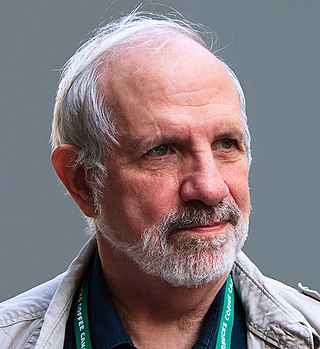
Brian Russell De Palma is an American film director and screenwriter. With a career spanning over 50 years, he is best known for work in the suspense, crime and psychological thriller genres. His films include mainstream box office hits such as Carrie (1976), Dressed to Kill (1980), Scarface (1983), The Untouchables (1987), and Mission: Impossible (1996), as well as cult favorites such as Sisters (1972), Phantom of the Paradise (1974), Blow Out (1981), Body Double (1984), Casualties of War (1989), and Carlito's Way (1993).
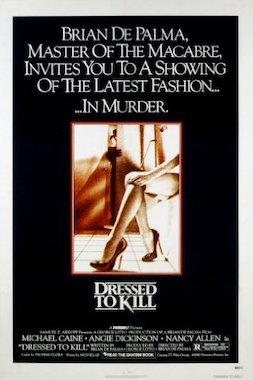
Dressed to Kill is a 1980 American erotic psychological thriller film written and directed by Brian De Palma, and starring Michael Caine, Angie Dickinson and Nancy Allen. It depicts the events leading up to the brutal murder of a New York City housewife (Dickinson) before following a prostitute (Allen) who witnesses the crime, and her attempts to solve it with the help of the victim's son. It contains several direct references to Alfred Hitchcock's 1960 film Psycho.

Psycho is a 1960 American horror film produced and directed by Alfred Hitchcock. The screenplay, written by Joseph Stefano, was based on the 1959 novel of the same name by Robert Bloch. The film stars Anthony Perkins, Janet Leigh, Vera Miles, John Gavin, and Martin Balsam. The plot centers on an encounter between on-the-run embezzler Marion Crane (Leigh) and shy motel proprietor Norman Bates (Perkins) and its aftermath, in which a private investigator (Balsam), Marion's lover Sam Loomis (Gavin), and her sister Lila (Miles) investigate her disappearance.
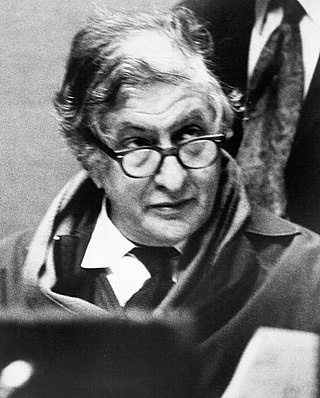
Bernard Herrmann was an American composer and conductor best known for his work in composing for films. As a conductor, he championed the music of lesser-known composers. He is widely regarded as one of the greatest film composers. Alex Ross writes that "Over four decades, he revolutionized movie scoring by abandoning the illustrative musical techniques that dominated Hollywood in the 1930s and imposing his own peculiar harmonic and rhythmic vocabulary."

Peeping Tom is a 1960 British psychological horror-thriller film directed by Michael Powell, written by Leo Marks, and starring Carl Boehm, Anna Massey, and Moira Shearer. The film revolves around a serial killer who murders women while using a portable film camera to record their dying expressions of terror, putting his footage together into a snuff film used for his own self pleasure. Its title derives from the expression "peeping Tom", which describes a voyeur.

Frenzy is a 1972 British thriller film directed by Alfred Hitchcock. It is the penultimate feature film of his extensive career. The screenplay by Anthony Shaffer was based on the 1966 novel Goodbye Piccadilly, Farewell Leicester Square by Arthur La Bern. The film stars Jon Finch, Alec McCowen and Barry Foster and features Billie Whitelaw, Anna Massey, Barbara Leigh-Hunt, Bernard Cribbins and Vivien Merchant. The original music score was composed by Ron Goodwin.

Vera June Miles is an American retired actress, best known for roles in the John Ford directed, John Wayne starring Westerns The Searchers (1956) and The Man Who Shot Liberty Valance (1962) as well as for playing Lila Crane in the Alfred Hitchcock film Psycho, later reprising the role in its sequel, Psycho II.

Blow Out is a 1981 American neo-noir mystery thriller film written and directed by Brian De Palma. The film stars John Travolta as Jack Terry, a movie sound effects technician from Philadelphia who, while recording sounds for a low-budget slasher film, unintentionally captures audio evidence of an assassination involving a presidential hopeful. Nancy Allen stars as Sally Bedina, a young woman involved in the crime. The supporting cast includes John Lithgow and Dennis Franz. The film's tagline in advertisements was, "Murder has a sound all of its own".
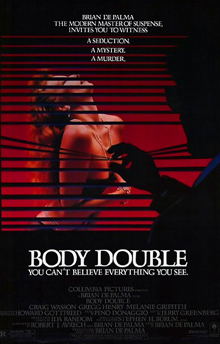
Body Double is a 1984 American neo-noir erotic thriller film directed, co-written, and produced by Brian De Palma. It stars Craig Wasson, Gregg Henry, Melanie Griffith and Deborah Shelton. The film is a direct homage to the 1950s films of Alfred Hitchcock, specifically Rear Window, Vertigo and Dial M for Murder, taking plot lines and themes from the first two.
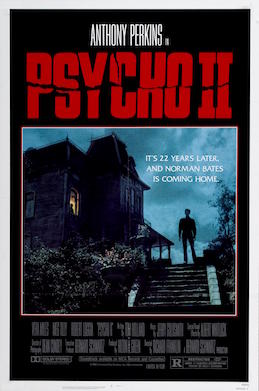
Psycho II is a 1983 American psychological slasher film directed by Richard Franklin, written by Tom Holland, and starring Anthony Perkins, Vera Miles, Robert Loggia, and Meg Tilly. It is the first sequel to Alfred Hitchcock's 1960 film Psycho and the second film in the Psycho franchise. Set 22 years after the first film, it follows Norman Bates after he is released from the mental institution and returns to the house and Bates Motel to continue a normal life. However, his troubled past continues to haunt him as someone begins to murder the people around him. The film is unrelated to the 1982 novel Psycho II by Robert Bloch, which he wrote as a sequel to his original 1959 novel Psycho.

Psycho III is a 1986 American slasher film, and the third film in the Psycho franchise. It stars Anthony Perkins, who also directs the film, reprising the role of Norman Bates. It co-stars Diana Scarwid, Jeff Fahey, and Roberta Maxwell. The screenplay is written by Charles Edward Pogue. The original electronic music score is composed and performed by Carter Burwell in one of his earliest projects. Psycho III is unrelated to Robert Bloch's third Psycho novel, Psycho House, which was released in 1990.
Psychological thriller is a genre combining the thriller and psychological fiction genres. It is commonly used to describe literature or films that deal with psychological narratives in a thriller or thrilling setting.

Psycho is a 1998 American psychological horror film produced and directed by Gus Van Sant, and starring Vince Vaughn, Julianne Moore, Viggo Mortensen, William H. Macy, and Anne Heche. It is a modern remake of Alfred Hitchcock's 1960 film of the same name, in which an embezzler arrives at an old motel run by a mysterious man named Norman Bates; both films are adapted from Robert Bloch's 1959 novel.

Psycho is an American horror franchise that began with the novels Psycho, Psycho II, and Psycho House by Robert Bloch, and was popularised by the film adaptations Psycho, Psycho II, Psycho III, Bates Motel, Psycho IV: The Beginning, the 1998 remake of the original film, and additional merchandise spanning various media. The first film, Psycho, was directed by filmmaker Alfred Hitchcock. Subsequently, another film related to the series was made: an Alfred Hitchcock biopic, and two new novels, by Takekuni Kitayama and Chet Williamson, were released. Also, an independent documentary called The Psycho Legacy was released on October 19, 2010, mostly focusing on Psycho II, Psycho III and Psycho IV: The Beginning, while covering the impact and legacy of the original film.
Hitchcockian films are those made by various filmmakers, with the styles and themes similar to those of Alfred Hitchcock.

Sisters is a 2006 independent horror film directed by Douglas Buck. A remake of the 1972 Brian De Palma film of the same name, it stars Stephen Rea, Lou Doillon, and Chloë Sevigny in the leading roles, with Dallas Roberts and JR Bourne playing supporting characters.
"The Murder" is a cue in the cinematic score written and composed by Bernard Herrmann for the horror-thriller film Psycho (1960) directed by Alfred Hitchcock. The score, its second movement in particular, is well recognized as one of the most famous scores in film history. It's composed for an original orchestra's string section.
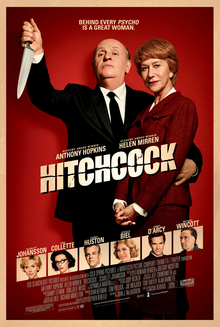
Hitchcock is a 2012 American biographical romantic drama film directed by Sacha Gervasi and based on Stephen Rebello's 1990 non-fiction book Alfred Hitchcock and the Making of Psycho. Hitchcock tells the story of the relationship between Alfred Hitchcock and his wife, Alma Reville, during the filming of Psycho in 1959. Hitchcock premiered at the AFI Fest on November 1, 2012 and was released in the United States on November 23 by Fox Searchlight Pictures. It grossed $27 million against a $15 million budget.
Art horror or arthouse horror is a sub-genre of both horror films and art-films. It explores and experiments with the artistic uses of horror.
















